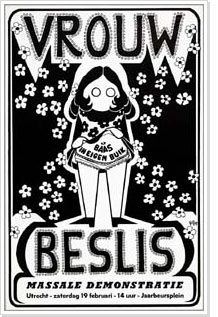Women in action! > Second feminist wave
 The second feminist wave, which lasted roughly from 1965 to 1985, was a new phase in the women's movement. It was born out of a feeling of dissatisfaction felt by many women about their position in society. Joke Kool-Smit argued in her famous article 'The dissatisfaction of women' that men and women were formally equals, but that in practice, women were still expected to occupy themselves with housekeeping and childcare. Joke Smit emphasised the point that men and women would not be equals until men would do more caring and women would do more paid working.
The second feminist wave, which lasted roughly from 1965 to 1985, was a new phase in the women's movement. It was born out of a feeling of dissatisfaction felt by many women about their position in society. Joke Kool-Smit argued in her famous article 'The dissatisfaction of women' that men and women were formally equals, but that in practice, women were still expected to occupy themselves with housekeeping and childcare. Joke Smit emphasised the point that men and women would not be equals until men would do more caring and women would do more paid working.
In later 1968, Joke Smit founded the action group Man Vrouw Maatschappij (Man Woman Society) together with Hedy d'Ancona and other kindred spirits. MVM campaigned for better education, childcare and the right to free abortion. A second action group appeared in late 1969: Dolle Mina (Wild Mina). Dolle Mina is best known for happenings like 'Baas in eigen buik' ('Boss of our own bellies'), for the right to self-determination of one's own body and the right to free abortion. A law was passed in 1981 that allowed for the possibility of abortion. The women's movement was not altogether satisfied about this law, which was viewed as patronising.
An important aspect of the second feminist wave is that feminists targeted educational programmes and contents of universities and colleges, and began to establish gender studies. Feminists were able to reach large groups of women through educational and instructional work.
The passing of the Equal Treatment Act in 1992 settled the feminist battle on paper. But feminists have remained active since then. This is sometimes referred to as the third feminist wave, but there are also people who feel that emancipation has now been accomplished. There has been much recent discussion on the relationship between religion and feminism, triggered in large part by the position of Islamic women in the Netherlands.
